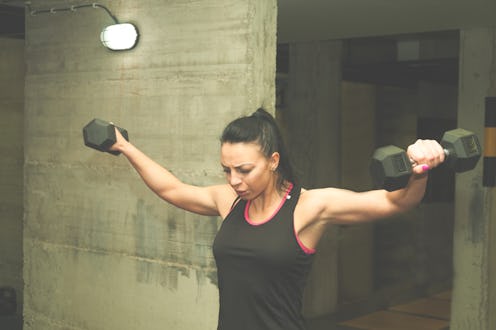Life
4 Ways Exercise Affects Your Period

If you’re someone who loves a good workout (or, for that matter, someone who would really rather stay home, but who forces yourself to go move your body anyway), it’s important for you to know how exercise affects your period.
We all know that exercise is good for you in a lot of significant ways.
"In general, exercise is good," Dr. Cordelia Carter, orthopedic surgeon and Director of Women’s Sports Medicine at NYU Langone, tells Bustle. "There are data to support a role for regular exercise in mitigating period-related symptoms. One recent study out of Taiwan found that women who exercised reported fewer backaches, headaches, and less general bodily discomfort (e.g., cramps) and period-related pain. They also had fewer GI symptoms like diarrhea and constipation, and reported fewer mood swings —specifically, women who exercised had less irritability, emotional lability and fewer symptoms of depression or 'feeling down' than women who didn’t."
Moreover, the Centers for Disease Control report that regular exercise (which is often defined as two and a half hours of moderate intensity aerobic activity per week) can decrease your risk for cardiovascular disease, metabolic syndrome, type 2 diabetes, and some types of cancer.
Basically, exercise can be magic for your body. However, if you’re a person who menstruates, then you need be aware of how exercise interacts with your period — especially if you have an intense workout regimen. That’s because, although exercise can promote general good health and help to alleviate some of the symptoms of PMS, too much exercise can create problems for your menstrual cycle, which, in turn, can lead to other major health problems.
Keep reading for four major ways that exercise affects your period, in both good and bad ways:
1. Too Much Exercise Can MakeYour Period Disappear
In general, exercise is great for health, but if you exercise too much, you can cause a condition known as amenorrhea, or the absence of periods. Not having to deal with menstruation may seem like a good thing, but amenorrhea can have serious long-term consequences for your health and your future ability to exercise.
"This results from a hormonal disruption that occurs usually as a consequence of underfueling (not taking in enough or enough quality calories to support one’s daily physical activities)," Dr. Carter says. "Energy is shunted towards maintaining the most critical biologic processes and normal sex hormone production and regulation may become unsustainable, which manifests as loss of the normal period."
Intense exercise can still interfere with menstruation by triggering the release of stress hormones that mess with your body’s ability to release the hormones necessary for a normal menstrual cycle.
Amenorrhea is dangerous because it is accompanied by abnormally low levels of estrogen in your system, and this lack of estrogen can cause you to develop brittle bones (aka, osteoporosis). That means that, even if you are young, exercise a lot, and are in good health, you have an increased risk of bone fractures now, as well as decreased bone density in the years going forward. If you exercise a lot and your period has disappeared or become infrequent, talk to your doctor. They may be able to prescribe medication (such as the birth control pill) that will help supplement your estrogen and protect the long-term health of your bones.
2. Excessive Exercise Can Cause Spotting
Excessive exercise is much more likely to cause your period to stop than trigger bleeding, but sometimes overly intense exercise, as well as stress and weight loss, can mess with your normal hormone function and cause spotting between periods.
3. Exercise Can Help To Relieve Menstrual Cramps
If you suffer from painful cramping every month, you may find that regular exercise helps to provide some relief. According to Gustavo Rossi, MD, an obstetrician-gynecologist at Virginia Hospital Center in Arlington, exercising releases endorphins, which can help relieve menstrual pain. “It produces analgesia [pain relief] and helps to burn the prostaglandins — chemicals released during menstruation that cause muscle contractions — much faster,” Rossi told WebMD. To relieve period pain, try to focus on aerobic activities, like walking, swimming, running, or cycling (anything that gets your heart rate up and your blood flowing). Yoga also helps, Dr. Carter says.
4. Exercise Can Also Help With Other Symptoms Of PMS
The benefits of exercise extend beyond helping you cope with menstrual cramps. The American Congress of Obstetricians and Gynecologists recommends regular exercise (at least 30 minutes a day, most days) as a treatment for a variety of PMS symptoms, including headaches, depression, and fatigue. The organization stipulates that, for exercise to effectively treat PMS, you should exercise regularly, including on days when you’re not having PMS symptoms. (And why not? You’ll get all of the other great effects of exercise regardless).
At the end of the day, as long as you're working out in moderation, it's going to be good for you. "Any kind of exercise is likely to be beneficial," Dr. Carter says. "While it may be tempting to use your period as an excuse to stay on the couch, the data tell us that you’ll feel better if you stay physically active, doing something fun and enjoyable." I'll raise a menstrual cup to that.
This post was originally published on June 1, 2016. It was updated on June 14, 2019.
This article was originally published on